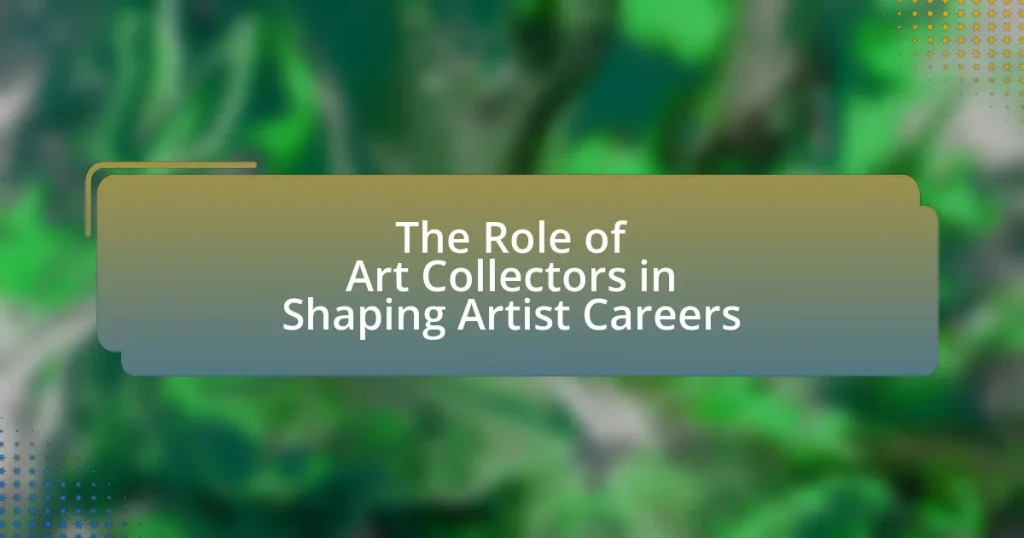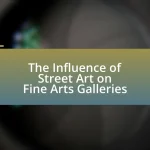Art collectors are pivotal figures in shaping artist careers, providing essential financial support, visibility, and validation. Their acquisitions not only enhance an artist’s market reputation but also facilitate networking opportunities that can lead to exhibitions and collaborations. The article explores how collectors influence artist visibility, promote their work, and impact artistic trends, while also addressing the challenges artists face in their relationships with collectors, including issues of valuation and creative freedom. Additionally, it examines the various types of collectors and their roles in the art ecosystem, highlighting the importance of mentorship and strategic engagement for artists navigating the complexities of the art market.
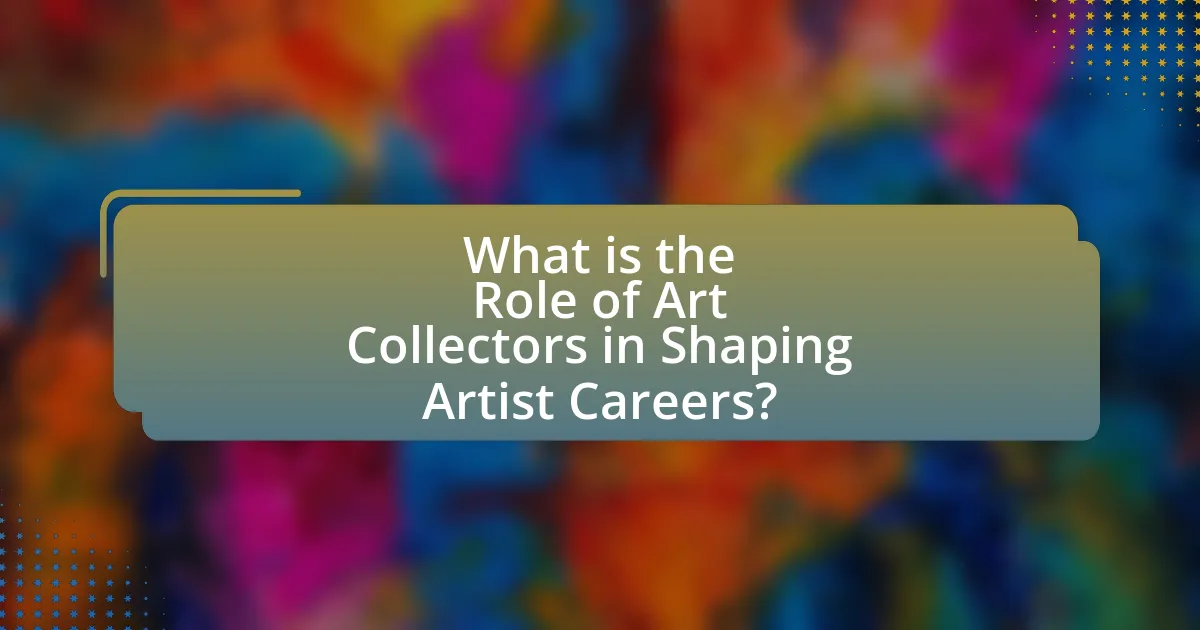
What is the Role of Art Collectors in Shaping Artist Careers?
Art collectors play a crucial role in shaping artist careers by providing financial support, visibility, and validation. By purchasing artworks, collectors not only offer artists immediate income but also enhance their market reputation, which can lead to further sales and opportunities. For instance, high-profile collectors often influence the art market, as their acquisitions can elevate an artist’s status and attract attention from galleries and institutions. Additionally, collectors frequently promote artists within their networks, facilitating connections that can lead to exhibitions and collaborations. This dynamic illustrates how the actions of collectors directly impact the trajectory of an artist’s career, making them pivotal figures in the art ecosystem.
How do art collectors influence the visibility of artists?
Art collectors significantly influence the visibility of artists by purchasing and showcasing their work, which elevates the artists’ profiles in the art market. When collectors acquire pieces from emerging or lesser-known artists, they often display these works in their homes, galleries, or exhibitions, thereby introducing the artists to broader audiences. For instance, high-profile collectors like Charles Saatchi have been known to propel artists into the limelight, as seen with the Young British Artists movement in the 1990s, where Saatchi’s collection brought attention to artists like Damien Hirst and Tracey Emin. This visibility can lead to increased demand for the artists’ work, higher prices, and opportunities for exhibitions, ultimately shaping their careers and market presence.
What methods do collectors use to promote artists?
Collectors promote artists primarily through networking and visibility strategies. They leverage their connections within the art community to introduce artists to galleries, curators, and potential buyers, thereby increasing the artist’s exposure. For instance, collectors often host private viewings or exhibitions featuring the artists they support, which can lead to sales and further opportunities. Additionally, collectors may write about the artists in publications or on social media platforms, enhancing the artists’ reputations and reach. This active engagement not only elevates the artists’ profiles but also contributes to their market value, as seen in cases where collectors’ endorsements have significantly boosted an artist’s career trajectory.
How does visibility impact an artist’s career trajectory?
Visibility significantly impacts an artist’s career trajectory by enhancing their recognition and opportunities within the art market. Increased visibility allows artists to reach broader audiences, attract potential buyers, and gain critical acclaim, which can lead to higher sales and exhibition opportunities. For instance, artists featured in prominent galleries or art fairs often experience a surge in demand for their work, as evidenced by the fact that artists showcased at Art Basel have reported sales increases of up to 300% following the event. This correlation between visibility and career advancement underscores the importance of strategic exposure in shaping an artist’s professional path.
Why are art collectors considered key stakeholders in the art market?
Art collectors are considered key stakeholders in the art market because they significantly influence demand, pricing, and the overall direction of artistic trends. Their purchasing decisions can elevate an artist’s profile, directly impacting the artist’s career trajectory and market value. For instance, when prominent collectors acquire works from emerging artists, it often leads to increased visibility and credibility, which can result in higher prices and greater opportunities for those artists. Additionally, collectors often drive the narrative around art by choosing which pieces to showcase, thereby shaping public perception and market dynamics.
What power dynamics exist between collectors and artists?
Power dynamics between collectors and artists are characterized by the influence collectors have over artists’ careers and market visibility. Collectors often control access to financial resources and exposure, which can significantly impact an artist’s ability to succeed. For instance, collectors who purchase and promote an artist’s work can elevate their status in the art world, leading to increased demand and higher prices for their art. Conversely, artists may feel pressured to conform to collectors’ preferences or trends to secure sales, which can limit their creative freedom. This dynamic is evident in the art market, where high-profile collectors can dictate trends and establish the value of artworks, thereby shaping the careers of emerging and established artists alike.
How do collectors’ preferences shape artistic trends?
Collectors’ preferences significantly shape artistic trends by influencing which styles, mediums, and artists gain visibility and market value. When collectors favor specific genres or techniques, they create demand that encourages artists to produce work aligned with those preferences. For example, the rise of contemporary art in the late 20th century was largely driven by collectors who sought innovative and experimental pieces, leading to a proliferation of new artistic movements such as conceptual art and installation art. This trend is evidenced by auction results, where works by favored artists often sell for exponentially higher prices, thereby validating and promoting those artistic directions. Consequently, the preferences of collectors not only dictate market trends but also impact the creative choices of artists, steering the overall trajectory of the art world.
What are the different types of art collectors?
There are several types of art collectors, including institutional collectors, private collectors, and corporate collectors. Institutional collectors, such as museums and galleries, focus on acquiring works that enhance their collections and serve educational purposes. Private collectors typically seek art for personal enjoyment and investment, often specializing in specific genres or periods. Corporate collectors acquire art to enhance their business environments and reflect their brand identity. Each type of collector plays a significant role in the art market, influencing trends and supporting artists’ careers through their acquisitions and exhibitions.
How do institutional collectors differ from private collectors?
Institutional collectors differ from private collectors primarily in their objectives and resources. Institutional collectors, such as museums and galleries, focus on acquiring artworks for public display, education, and preservation, often guided by curatorial missions and institutional budgets. In contrast, private collectors typically acquire art for personal enjoyment, investment, or status, driven by individual preferences and financial capacity.
For example, according to the American Alliance of Museums, institutional collections often prioritize works that contribute to cultural heritage and community engagement, while private collections may reflect personal taste and market trends. This distinction highlights how institutional collectors play a significant role in shaping the art world by influencing which artists gain visibility and recognition, whereas private collectors may prioritize different aspects of art ownership.
What role do emerging collectors play in the art ecosystem?
Emerging collectors play a crucial role in the art ecosystem by providing financial support and visibility to new artists. Their purchases often help to establish an artist’s career, as emerging collectors are typically more willing to take risks on unproven talent compared to established collectors. This willingness to invest in new work can lead to increased recognition and opportunities for artists, such as gallery representation and exhibition invitations. According to a 2021 report by Art Basel and UBS, emerging collectors are driving a significant portion of the contemporary art market, indicating their growing influence and importance in shaping artistic careers.
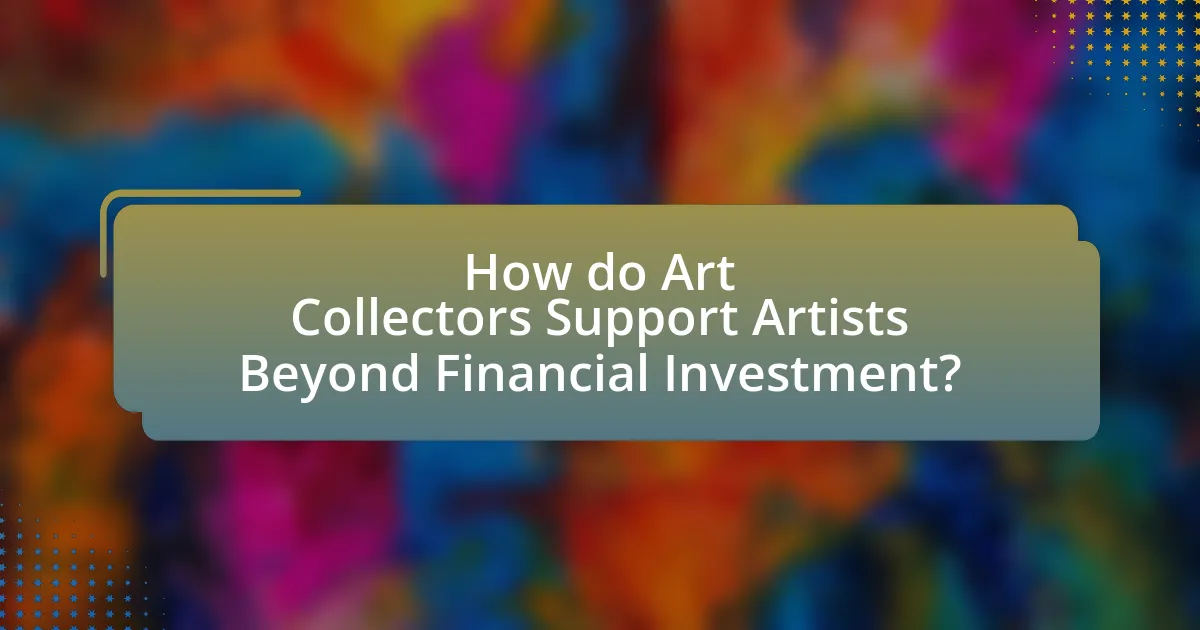
How do Art Collectors Support Artists Beyond Financial Investment?
Art collectors support artists beyond financial investment by providing exposure, networking opportunities, and mentorship. Exposure occurs when collectors showcase artists’ work in their homes or public spaces, increasing visibility and attracting potential buyers or collaborators. Networking opportunities arise as collectors often have connections within the art world, facilitating introductions to galleries, curators, and other collectors, which can lead to exhibitions and sales. Additionally, collectors may offer mentorship, sharing their knowledge and experience to help artists navigate the complexities of the art market and develop their careers. These forms of support are crucial for artists, especially emerging ones, as they help build reputations and foster professional growth.
What mentorship opportunities do collectors provide to artists?
Collectors provide mentorship opportunities to artists through networking, financial support, and guidance on market trends. By leveraging their connections, collectors can introduce artists to galleries, curators, and other industry professionals, enhancing the artist’s visibility and career prospects. Financially, collectors may offer funding for projects or exhibitions, allowing artists to focus on their creative work without financial strain. Additionally, collectors often share insights about the art market, helping artists understand pricing, audience engagement, and promotional strategies, which are crucial for long-term success. This mentorship can significantly influence an artist’s career trajectory and professional development.
How can collectors help artists develop their careers?
Collectors can help artists develop their careers by providing financial support through purchasing artwork, which enables artists to sustain their practice and invest in new projects. This financial backing allows artists to focus on their creative work without the burden of financial instability. Additionally, collectors often have extensive networks and can introduce artists to galleries, curators, and other collectors, facilitating opportunities for exhibitions and collaborations. For instance, a study by the National Endowment for the Arts highlights that artists with strong collector relationships are more likely to secure gallery representation and increase their visibility in the art market. Thus, collectors play a crucial role in both the economic and social aspects of an artist’s career development.
What networks do collectors connect artists to?
Collectors connect artists to networks that include galleries, auction houses, and art fairs. These networks provide artists with visibility, opportunities for sales, and access to influential industry professionals. For instance, galleries often showcase artists’ work, while auction houses facilitate high-profile sales that can elevate an artist’s reputation. Art fairs serve as platforms for networking and exposure to a broader audience, including potential buyers and critics. Collectors play a crucial role in bridging these connections, thereby significantly impacting artists’ careers and market presence.
How do collectors contribute to an artist’s professional development?
Collectors contribute to an artist’s professional development by providing financial support, exposure, and validation of their work. Financially, collectors purchase artworks, which allows artists to sustain their practice and invest in new projects. Exposure occurs when collectors showcase the artist’s work in their collections or at exhibitions, increasing visibility within the art community. Validation is achieved through the collector’s endorsement, as owning an artist’s work can enhance the artist’s reputation and credibility. For instance, notable collectors like Charles Saatchi have significantly impacted the careers of contemporary artists by acquiring and promoting their work, leading to increased demand and recognition in the art market.
What resources do collectors offer for skill enhancement?
Collectors offer mentorship, networking opportunities, and financial support for skill enhancement. Mentorship from experienced collectors can provide artists with valuable insights into the art market and creative processes. Networking opportunities facilitated by collectors can connect artists with industry professionals, leading to collaborations and exposure. Financial support, such as funding for workshops or materials, enables artists to develop their skills further. These resources collectively contribute to the professional growth and artistic development of emerging artists.
How can collectors assist in navigating the art market?
Collectors can assist in navigating the art market by providing valuable insights and connections that enhance understanding of market trends and artist reputations. Their experience allows them to identify emerging artists and assess the potential value of artworks, which is crucial for both new and seasoned buyers. For instance, collectors often attend art fairs and exhibitions, where they can share firsthand knowledge about the quality and marketability of specific pieces or artists. This information is vital, as the art market can be opaque and complex, with prices influenced by various factors such as provenance, artist recognition, and current trends. Additionally, collectors may also facilitate introductions between artists and galleries, further supporting artists’ careers and helping buyers make informed decisions.
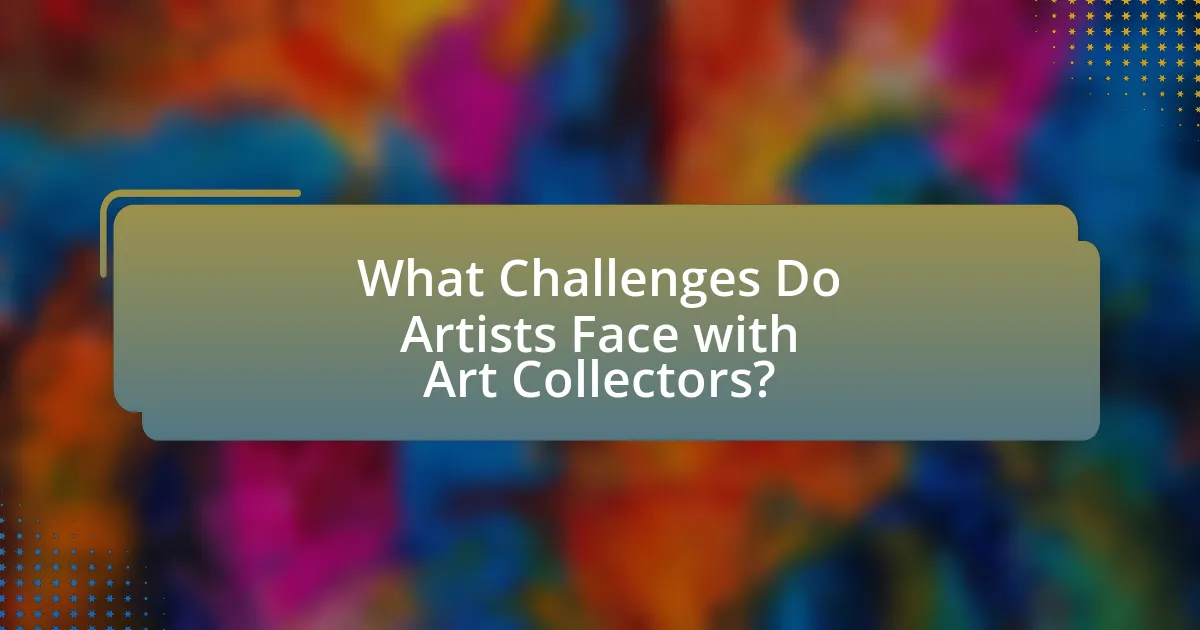
What Challenges Do Artists Face with Art Collectors?
Artists face several challenges with art collectors, primarily including issues of valuation, communication, and market access. Valuation challenges arise when collectors may undervalue an artist’s work, impacting the artist’s financial stability and perceived worth in the market. Communication barriers can lead to misunderstandings regarding the artist’s intentions, pricing, and the narrative behind the artwork, which can hinder the relationship between artists and collectors. Additionally, limited access to collectors can restrict an artist’s opportunities for exposure and sales, particularly for emerging artists who may struggle to connect with established collectors. These challenges can significantly influence an artist’s career trajectory and overall success in the art market.
How can the relationship between artists and collectors become problematic?
The relationship between artists and collectors can become problematic due to power imbalances and conflicting interests. Artists may feel pressured to create work that aligns with collectors’ preferences rather than their own artistic vision, leading to a loss of authenticity. Additionally, collectors may exert control over pricing and marketability, which can undermine the artist’s ability to establish their own value in the art market. This dynamic can result in artists compromising their creative integrity to satisfy collectors, ultimately affecting their career trajectory and artistic development.
What ethical dilemmas arise in collector-artist relationships?
Ethical dilemmas in collector-artist relationships include issues of power imbalance, financial exploitation, and conflicts of interest. Collectors often hold significant influence over an artist’s career trajectory, which can lead to situations where artists may feel pressured to conform to the collector’s preferences or demands, potentially compromising their artistic integrity. Financial exploitation can occur when collectors undervalue an artist’s work or manipulate pricing, undermining the artist’s ability to earn a fair income. Additionally, conflicts of interest may arise when collectors also act as dealers or curators, creating a scenario where their personal interests could overshadow the artist’s best interests. These dilemmas highlight the complexities of the relationships and the need for ethical standards to protect artists.
How can dependency on collectors affect an artist’s creative freedom?
Dependency on collectors can significantly restrict an artist’s creative freedom by imposing commercial pressures that prioritize marketability over artistic expression. When artists rely heavily on collectors for financial support, they may feel compelled to create works that align with the tastes and preferences of these collectors, rather than pursuing their own innovative ideas. This dynamic can lead to a homogenization of artistic output, as artists cater to the demands of the market, potentially stifling originality and experimentation. Historical examples, such as the influence of major art collectors in the 20th century, illustrate how financial backing can dictate artistic direction, often resulting in a compromise between personal vision and commercial viability.
What strategies can artists employ to manage collector relationships?
Artists can employ several strategies to manage collector relationships effectively. First, consistent communication is crucial; artists should regularly update collectors on new works, exhibitions, and personal insights into their creative process. This builds trust and keeps collectors engaged. Second, personalized interactions enhance relationships; artists can send thank-you notes or invite collectors to exclusive events, fostering a sense of belonging. Third, transparency regarding pricing and availability helps manage expectations and prevents misunderstandings. Additionally, artists can create a collector’s club or community, offering members exclusive access to new pieces and behind-the-scenes content, which strengthens loyalty. These strategies are supported by the fact that strong relationships with collectors can lead to increased sales and long-term support, as evidenced by numerous successful artists who prioritize collector engagement.
How can artists maintain their artistic integrity while working with collectors?
Artists can maintain their artistic integrity while working with collectors by establishing clear boundaries regarding their creative vision and the terms of engagement. This involves openly communicating their artistic goals and ensuring that any commissions or requests align with their personal style and values. For instance, artists can set guidelines on how much creative freedom they retain in commissioned works, thereby preventing undue influence from collectors.
Additionally, artists can prioritize relationships with collectors who respect their artistic process and support their vision, as evidenced by successful collaborations that have led to mutual growth without compromising artistic values. Research indicates that artists who engage with supportive collectors often experience enhanced creative output and satisfaction, reinforcing the importance of aligning with individuals who appreciate their work authentically.
What best practices should artists follow when engaging with collectors?
Artists should prioritize building genuine relationships with collectors to enhance engagement and foster long-term support. Establishing trust through consistent communication, sharing insights about their work, and being transparent about their artistic process can significantly strengthen these connections. Additionally, artists should actively seek feedback from collectors, as this demonstrates respect for their opinions and can lead to valuable insights that inform future work. Engaging collectors through exclusive previews or private viewings of new pieces can also create a sense of inclusion and investment in the artist’s journey. These practices are supported by the fact that artists who maintain strong relationships with collectors often see increased sales and opportunities for collaboration, as highlighted in various art market studies.










